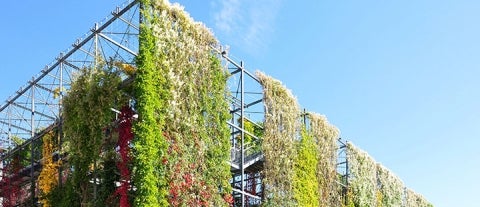A team of Yale researchers has received National Science Foundation funding to develop a new class of “green wall” technologies capable of rejecting waste heat for a range of processes — from utility-scale power operations to home-cooling systems — a potentially valuable green infrastructure alternative to the cooling towers that have become ubiquitous worldwide.
During a three-year study, the team will test and evaluate green wall prototypes that incorporate a “heat rejection” function — a process in which cooler water is used to extract waste heat from water streams in built systems — while still achieving the benefits associated with typical green wall systems.
Green walls, which are also known as living walls, are vegetation-covered walls located on the exterior of buildings that can improve the energy performance and water management of the structure, reduce the urban heat island effect, and provide other valuable ecosystem services.
Yet despite their practical and ecological benefits, the high implementation and maintenance costs have made green wall technologies something of a niche product, said
Alexander Felson, co-principal investigator of the project and assistant professor at the Yale School of Forestry & Environmental Studies (F&ES) and the Yale School of Architecture.
A green wall that can also perform the function of heat rejection has the potential to complement or replace cooling towers, which typically achieve that task for systems of all sizes across the industrial and urban landscape. The technology, researchers say, could become an attractive option for large-scale utility customers, big box department stores, and urban buildings. It might also bring the efficiency benefits of wet heat rejection to smaller building cooling systems.
“There is real potential to expand green wall technologies into a whole new set of markets,” Felson said. “If you can incorporate active heat rejection into green walls — and illustrate the ecosystem service benefits — it’s possible that we can expand the clientele to include any industry, institution, or even homeowners.”
Like cooling towers, the green walls would perform heat rejection through evaporation and convection. And for both technologies the water used to extract waste heat is lost to the atmosphere. However, green walls would utilize the re-circulated water for several additional functions, such as maintaining plants and soil organisms, graywater management for buildings, and microclimate moderation, researchers say.
In addition, the green wall systems would not produce “blow-down” water, which is high-mineral wastewater contaminated with the biocides and corrosive inhibitors used in cooling tower operations.
A key challenge will be identifying plant and substrate combinations that support heat rejection while allowing plants to perform in higher water temperatures and with wetter roots.
During the project, the researchers will conduct greenhouse and field studies to test heat rejection, water treatment, and plant and substrate performance alongside mathematicalmodelsto calibrate and/or validate the results.
Felson worked closely with co-principal investigator
James Axley, a Senior Research Scholar at F&ES and Professor Emeritus at the Yale School of Architecture, to develop the thermal green wall concepts. Together they have two provisional patents for the technology. A third investigator,
Graeme Berlyn, the E.H. Harriman Professor of Forest Management and Physiology of Trees at F&ES, will focus on the plant physiology and substrates.
The researchers are working with EcoWalls, LLC. a nationally recognized design-build company with greenhouse facilities that has produced numerous advancesin green wall plants, irrigation, and substrates.
The $299,000 grant is funded by the National Science Foundation’s Environmental Sustainability program.
